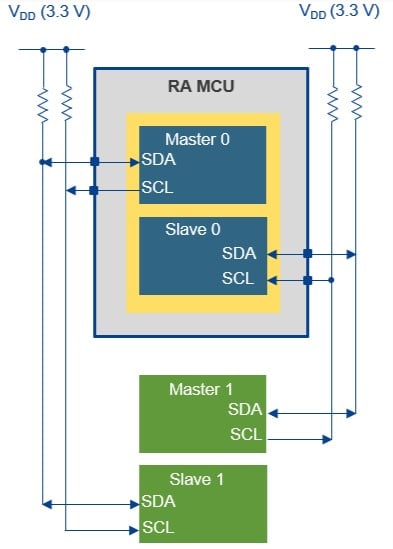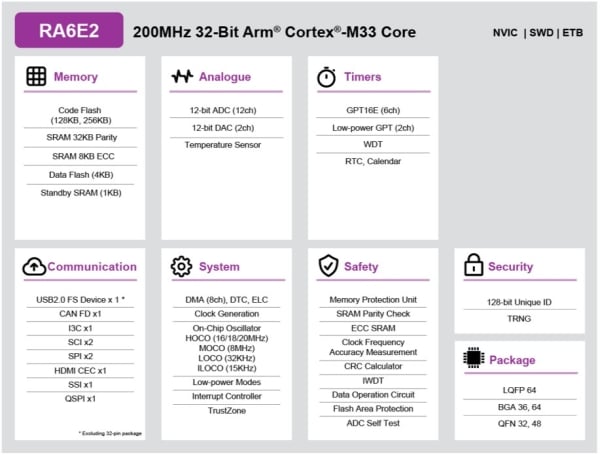In previous blogs in this series, we’ve looked at some of the more unusual peripherals available on many of the RA microcontrollers and how they can be used to help simplify and automate some of the basic housekeeping and I/O tasks that are common in microcontroller applications.
In this blog, we’re going to do something slightly different and look at a new peripheral, the I3C bus interface, which we have started to implement on some of our newest devices, such as the latest entry-level members of the RA family, the RA4E2 and RA6E2. You can see the block diagram of the new RA6E2 below.
Block Diagram of the new RA6E2 offering an I3C interface in small pin count devices down to 32 pins
The I3C interface (officially the “MIPI Alliance Improved Inter Integrated Circuit”) was initially developed by the MIPI alliance to support sensor interconnect in mobile applications. The MIPI Alliance is a global alliance of electronics companies that develop technical specifications for mobile applications, of which Renesas Electronics is a member.
The original concept behind the I3C interface was to standardize the communication between sensors and the host CPU, reduce the number of physical pins and the interconnect, and support low power, high speed communications. The aim was to replace the I2C and SPI busses that are typically used today in these applications and improve the specification. While the initial target was mobile devices, it soon became obvious that the same requirements are suitable for many other applications, where we have simple serial busses providing local interconnect between devices.
The I3C interface solves some of the issues that we have with the existing I2C and SPI buses. The I3C interface offers the following:
- Support for higher data rates
- Removes the need for additional pins to support chip selects (SPI) or interrupts
- Dynamic address
- Hot-plug support

The in-band interrupt function is particularly important as this can be used as a low-cost wake-up function and allows devices to enter a low power shutdown mode while still supporting correct operation on the bus.
Further, I3C can save considerable device power through higher data rates (because the device can be put back to sleep sooner), built-in configuration and control (without intruding on the main communication protocols), In-Band Interrupt (IBI) as a low-cost wake mechanism, and the ability for Targets to shut down all internal clocks while still operating correctly on the I3C interface.
I3C can also save power compared to that used by I2C as the power consumed per bit-transfer is more efficient than that achieved using the I2C bus, this is due to the use of push-pull (vs. Open-Drain) and strong Pull-Up signaling.
I3C offers backward compatibility with the I2C bus, supporting legacy devices and applications. However, some limitations have to be managed, such as the change from the open drain (I2C) to push-pull (I3C) for the clock and data lines and the lack of support for clock stretching, sometimes used to allow some I2C devices time to respond to a data request.
The full MIPI I3C specification is only available for members of the MIPI membership. However, the MIPI I3C basic specification bundles the most common I3C features and is available for use without MIPI membership allowing users to use the I3C interface in their interconnect applications.
The I3C interface provides a comprehensive upgrade to the I2C and SPI busses typically used to connect sensor and host CPU’s in many applications today, making it easier to transfer data between these devices, and to reduce the power consumption of the system.
In the next generation of smart sensors, many of which will have local processing requirements to minimize the host CPU load, devices like the RA4E2 and RA6E2 will provide ideal solutions. These devices support small package options like the 4 x 4 mm BGA while supporting the I3C interface, with an extremely high-performance core that makes them very attractive for these new applications.
You can find more details, including datasheets, on the RA4E2 product page and the RA6E2 product page.
You can find out more about the MIPI Alliance I3C interface on their website at www.mipi.org/specifications/i3c-sensor-specification.

